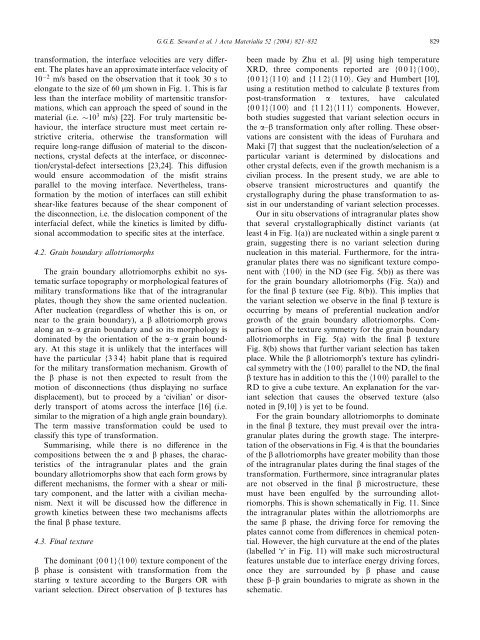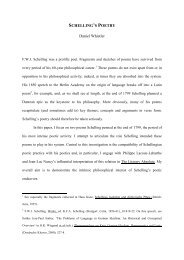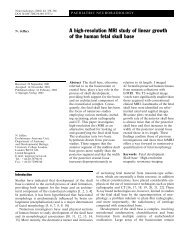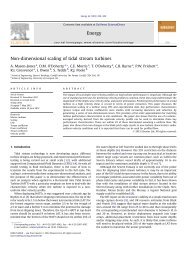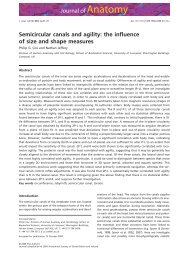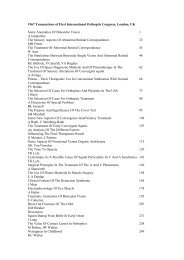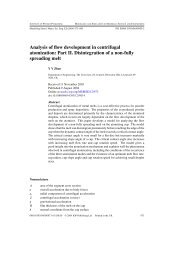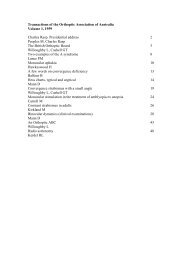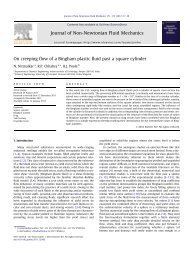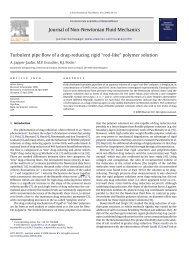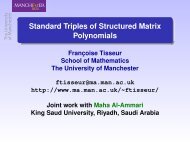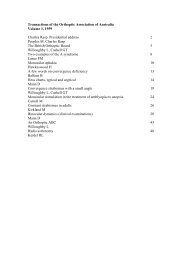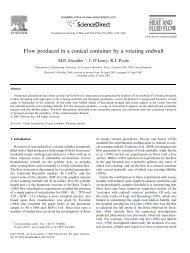In situ SEM-EBSD observations of the hcp to bcc phase ...
In situ SEM-EBSD observations of the hcp to bcc phase ...
In situ SEM-EBSD observations of the hcp to bcc phase ...
You also want an ePaper? Increase the reach of your titles
YUMPU automatically turns print PDFs into web optimized ePapers that Google loves.
G.G.E. Seward et al. / Acta Materialia 52 (2004) 821–832 829transformation, <strong>the</strong> interface velocities are very different.The plates have an approximate interface velocity <strong>of</strong>10 2 m/s based on <strong>the</strong> observation that it <strong>to</strong>ok 30 s <strong>to</strong>elongate <strong>to</strong> <strong>the</strong> size <strong>of</strong> 60 lm shown in Fig. 1. This is farless than <strong>the</strong> interface mobility <strong>of</strong> martensitic transformations,which can approach <strong>the</strong> speed <strong>of</strong> sound in <strong>the</strong>material (i.e. 10 3 m/s) [22]. For truly martensitic behaviour,<strong>the</strong> interface structure must meet certain restrictivecriteria, o<strong>the</strong>rwise <strong>the</strong> transformation willrequire long-range diffusion <strong>of</strong> material <strong>to</strong> <strong>the</strong> disconnections,crystal defects at <strong>the</strong> interface, or disconnection/crystal-defectintersections [23,24]. This diffusionwould ensure accommodation <strong>of</strong> <strong>the</strong> misfit strainsparallel <strong>to</strong> <strong>the</strong> moving interface. Never<strong>the</strong>less, transformationby <strong>the</strong> motion <strong>of</strong> interfaces can still exhibitshear-like features because <strong>of</strong> <strong>the</strong> shear component <strong>of</strong><strong>the</strong> disconnection, i.e. <strong>the</strong> dislocation component <strong>of</strong> <strong>the</strong>interfacial defect, while <strong>the</strong> kinetics is limited by diffusionalaccommodation <strong>to</strong> specific sites at <strong>the</strong> interface.4.2. Grain boundary allotriomorphsThe grain boundary allotriomorphs exhibit no systematicsurface <strong>to</strong>pography or morphological features <strong>of</strong>military transformations like that <strong>of</strong> <strong>the</strong> intragranularplates, though <strong>the</strong>y show <strong>the</strong> same oriented nucleation.After nucleation (regardless <strong>of</strong> whe<strong>the</strong>r this is on, ornear <strong>to</strong> <strong>the</strong> grain boundary), a b allotriomorph growsalong an a–a grain boundary and so its morphology isdominated by <strong>the</strong> orientation <strong>of</strong> <strong>the</strong> a–a grain boundary.At this stage it is unlikely that <strong>the</strong> interfaces willhave <strong>the</strong> particular {3 3 4} habit plane that is requiredfor <strong>the</strong> military transformation mechanism. Growth <strong>of</strong><strong>the</strong> b <strong>phase</strong> is not <strong>the</strong>n expected <strong>to</strong> result from <strong>the</strong>motion <strong>of</strong> disconnections (thus displaying no surfacedisplacement), but <strong>to</strong> proceed by a ÔcivilianÕ or disorderlytransport <strong>of</strong> a<strong>to</strong>ms across <strong>the</strong> interface [16] (i.e.similar <strong>to</strong> <strong>the</strong> migration <strong>of</strong> a high angle grain boundary).The term massive transformation could be used <strong>to</strong>classify this type <strong>of</strong> transformation.Summarising, while <strong>the</strong>re is no difference in <strong>the</strong>compositions between <strong>the</strong> a and b <strong>phase</strong>s, <strong>the</strong> characteristics<strong>of</strong> <strong>the</strong> intragranular plates and <strong>the</strong> grainboundary allotriomorphs show that each form grows bydifferent mechanisms, <strong>the</strong> former with a shear or militarycomponent, and <strong>the</strong> latter with a civilian mechanism.Next it will be discussed how <strong>the</strong> difference ingrowth kinetics between <strong>the</strong>se two mechanisms affects<strong>the</strong> final b <strong>phase</strong> texture.4.3. Final textureThe dominant {0 0 1}h100i texture component <strong>of</strong> <strong>the</strong>b <strong>phase</strong> is consistent with transformation from <strong>the</strong>starting a texture according <strong>to</strong> <strong>the</strong> Burgers OR withvariant selection. Direct observation <strong>of</strong> b textures hasbeen made by Zhu et al. [9] using high temperatureXRD, three components reported are {0 0 1}h100i,{0 0 1}h110i and {1 1 2}h110i. Gey and Humbert [10],using a restitution method <strong>to</strong> calculate b textures frompost-transformation a textures, have calculated{0 0 1}h100i and {1 1 2}h111i components. However,both studies suggested that variant selection occurs in<strong>the</strong> a–b transformation only after rolling. These <strong>observations</strong>are consistent with <strong>the</strong> ideas <strong>of</strong> Furuhara andMaki [7] that suggest that <strong>the</strong> nucleation/selection <strong>of</strong> aparticular variant is determined by dislocations ando<strong>the</strong>r crystal defects, even if <strong>the</strong> growth mechanism is acivilian process. <strong>In</strong> <strong>the</strong> present study, we are able <strong>to</strong>observe transient microstructures and quantify <strong>the</strong>crystallography during <strong>the</strong> <strong>phase</strong> transformation <strong>to</strong> assistin our understanding <strong>of</strong> variant selection processes.Our in <strong>situ</strong> <strong>observations</strong> <strong>of</strong> intragranular plates showthat several crystallographically distinct variants (atleast 4 in Fig. 1(a)) are nucleated within a single parent agrain, suggesting <strong>the</strong>re is no variant selection duringnucleation in this material. Fur<strong>the</strong>rmore, for <strong>the</strong> intragranularplates <strong>the</strong>re was no significant texture componentwith h100i in <strong>the</strong> ND (see Fig. 5(b)) as <strong>the</strong>re wasfor <strong>the</strong> grain boundary allotriomorphs (Fig. 5(a)) andfor <strong>the</strong> final b texture (see Fig. 8(b)). This implies that<strong>the</strong> variant selection we observe in <strong>the</strong> final b texture isoccurring by means <strong>of</strong> preferential nucleation and/orgrowth <strong>of</strong> <strong>the</strong> grain boundary allotriomorphs. Comparison<strong>of</strong> <strong>the</strong> texture symmetry for <strong>the</strong> grain boundaryallotriomorphs in Fig. 5(a) with <strong>the</strong> final b textureFig. 8(b) shows that fur<strong>the</strong>r variant selection has takenplace. While <strong>the</strong> b allotriomorphÕs texture has cylindricalsymmetry with <strong>the</strong> h100i parallel <strong>to</strong> <strong>the</strong> ND, <strong>the</strong> finalb texture has in addition <strong>to</strong> this <strong>the</strong> h100i parallel <strong>to</strong> <strong>the</strong>RD <strong>to</strong> give a cube texture. An explanation for <strong>the</strong> variantselection that causes <strong>the</strong> observed texture (alsonoted in [9,10] ) is yet <strong>to</strong> be found.For <strong>the</strong> grain boundary allotriomorphs <strong>to</strong> dominatein <strong>the</strong> final b texture, <strong>the</strong>y must prevail over <strong>the</strong> intragranularplates during <strong>the</strong> growth stage. The interpretation<strong>of</strong> <strong>the</strong> <strong>observations</strong> in Fig. 4 is that <strong>the</strong> boundaries<strong>of</strong> <strong>the</strong> b allotriomorphs have greater mobility than those<strong>of</strong> <strong>the</strong> intragranular plates during <strong>the</strong> final stages <strong>of</strong> <strong>the</strong>transformation. Fur<strong>the</strong>rmore, since intragranular platesare not observed in <strong>the</strong> final b microstructure, <strong>the</strong>semust have been engulfed by <strong>the</strong> surrounding allotriomorphs.This is shown schematically in Fig. 11. Since<strong>the</strong> intragranular plates within <strong>the</strong> allotriomorphs are<strong>the</strong> same b <strong>phase</strong>, <strong>the</strong> driving force for removing <strong>the</strong>plates cannot come from differences in chemical potential.However, <strong>the</strong> high curvature at <strong>the</strong> end <strong>of</strong> <strong>the</strong> plates(labelled ÔrÕ in Fig. 11) will make such microstructuralfeatures unstable due <strong>to</strong> interface energy driving forces,once <strong>the</strong>y are surrounded by b <strong>phase</strong> and cause<strong>the</strong>se b–b grain boundaries <strong>to</strong> migrate as shown in <strong>the</strong>schematic.


